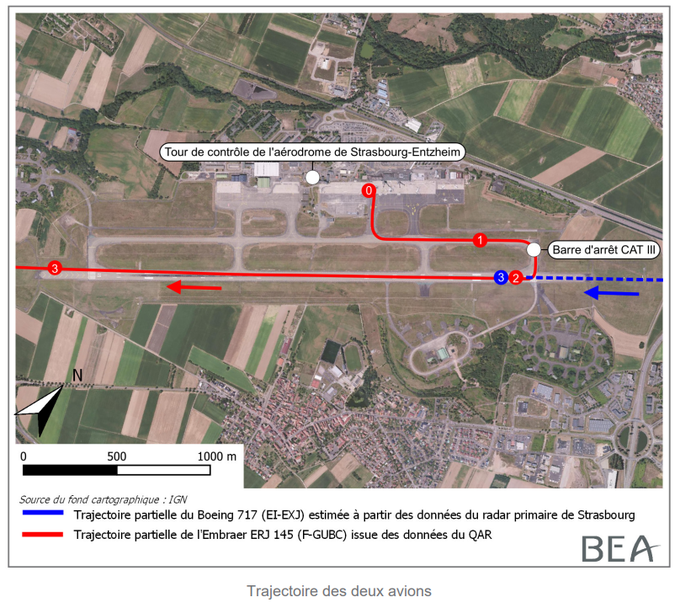


Loss of separation between an aircraft taking off (Embraer ERJ 145) and another aircraft on landing (Boeing 717-200).
Deviation from the path of the aircraft that was landing (Boeing 717-200).
Today, French BEA released the final report on the incident involving Boeing 717-200 (regd. EI-EXJ) operated by Volotea and Embraer ERJ 145 (regd. F-GUBC) operated by HOP! on 12/29/2016 at Strasbourg-Entzheim airport (SXB).
Donato Bolelli / Boeing 717-200 (regd. EI-EXJ)
In a Low Visibility Procedures (LVP) situation, the controller proposed immediate take-off to the crew of the Embraer ERJ 145 which was approaching the holding point for runway 23 while a Boeing 717 on approach ILS CAT III was at about 8 Runway threshold NM, established on the ILS with relatively high speed.
The crew of the ERJ 145 accepted immediate take-off without having received the " cabin OK " from the commercial crew or asking when the cabin would be ready for take-off.
The crew could not therefore judge at that time whether they were capable of carrying out such a take-off and the procedures of their operator did not allow them to do so, but their decision was motivated by respecting the time slot for take off.
The controller's strategy was based mainly on the ability of the crew of the ERJ 145 to follow the immediate take-off instruction, a factor he had no control over. He did not know the exact position of this aircraft because of the low visibility and the absence of ground radar at Strasbourg Entzheim aerodrome.
While the Boeing 717 was a little more than 1 NM from the runway threshold, the controller questioned the crew of the ERJ 145 on their position and the latter replied "take off ".
The controller did not instruct the crew of the Boeing 717 to abort the approach and cleared them for landing after noting the lifting of the wheels of the ERJ 145 when the latter was not had not yet cleared the sensitive areas of the ILS.
Even if this was contrary to the prescriptions of the SNA operations manual, the controller preferred this option so as not to have to manage two airplanes in flight, in catch-up with each other, without visual on the two airplanes.
The landing of the Boeing 717, in automatic mode, was probably disrupted by the presence of the ERJ 145 in the sensitive areas of the ILS after the end of the runway.
The captain of the Boeing 717 had to take control to land. However, it cannot be excluded that the Boeing 717 on landing was deported because of the turbulence generated by the ERJ145 which took off less than a minute before.
Markus Eigenheer, F-GUBC Embraer ERJ-145MP E145 - HOP
► The eagerness of the ERJ 145 crew to respect their time slot take-off. This eagerness led him:
► Insufficient consideration of the speed of the Boeing 717 by the controller;
► A radio exchange between the crew of the Boeing 717 and the controller at the passage of 4 NM could have allowed all the actors to have a better awareness of the situation;
► The lack of use by the controller of a specific phraseology relating to to LVP, which could have enabled him to better understand the position of the ERJ 145;
► The lack of communication from the controller not wishing to disturb the crew during take-off;
► The underestimation by the controller and by the crew of the Boeing 717 of the risks associated with a disturbance of the localizer signal by an aircraft in the areas sensitive ILS.
► This underestimation may have been encouraged by the will of the controller and crew of the Boeing 717 to avoid a low go-around height with an airplane taking off on the same runway, in low conditions visibility, which would have been a more complex situation for them to manage .

► Adopt a "non-aggressive" approach sequence by avoiding placing aircraft too close to each other in order to optimize the use of the track or favor a certain efficiency (strategic management by taking margins, without objective of achieving separation minima);
► Plan the occupation of the track by taking margins (unexpected factors);
► Inform pilots sufficiently early of any constraints;
► Continuously evaluate the evolution of what has been planned and adapt the action plan if the safety margins have been reduced;
► Communicate with pilots to share common situational awareness and limit the risk of a low go-around;
► Limitations: Difficult early taking into account of the actions undertaken by the pilots or runway incursions.
► React and decide quickly, avoiding letting go of situations or hoping that they will run smoothly;
► Inform the air traffic controllers sufficiently early of a possible go-around;
► Inform air traffic controllers of the impossibility or difficulties for a departure immediate (or to clear the runway);
► Limitations: Difficult early taking into account of actions undertaken by Air traffic controllers.
Source : BEA2017-0006 / Janvier 2022
